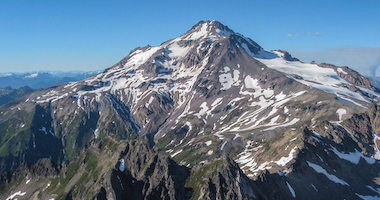McKinley, North America's highest peak, is a dream for many, and as the popularity of climbing the Seven Summits has increased over the last few decades, so has the Denali Dream. However, unlike other world-famous peaks, McKinley stands apart for its remoteness; the sheer physical strength required to drag and carry your provisions up the mountain makes it different from, say, Everest. At RMI Expeditions, we have 50 years of experience climbing Denali, and we're here to break down the challenges and how, with preparation, you can stand on the summit.
Understanding McKinley Climbing Difficulty
Here's why climbing McKinley is no small matter:
- Extreme Altitude: At 20,310 feet, oxygen is scarce, making altitude sickness a prevalent risk.
- Glacier Travel: Hidden crevasses demand rope work and crevasse rescue skills for safety.
- Physical Fitness: Long days, heavy loads, and the up-and-down of acclimatization mean you must be in peak physical shape for your McKinley expedition. Fitness issues are the most common reason clients don’t summit or leave the trip early.
- Subarctic Conditions: Expect extreme cold (as low as -70°F/-56°C), high winds, and unpredictable storms.
- Total Isolation: You are responsible for everything you need to survive and thrive for up to a month on McKinley's remote flanks. That means carrying it all yourself; no porters, sherpas, or yaks here.

Building Your Skills: A Proven Path to McKinley
McKinley is often the culmination of climbers’ North American mountaineering journey. Before attempting “the big one,” we recommend at least 2-3 expeditions to the Cascades and other glaciated peaks. These will prepare you for the risks and rewards of McKinley's 3-week journey. Here's a suggested path that incorporates some of our most popular programs:
- Introductory Glaciated Climb: introduces mountaineering techniques critical for McKinley, including glacier travel, rope work, and self-arrest. You'll gain valuable experience hiking with a heavy pack on challenging terrain and learn to operate in cold weather conditions, all under the supervision of our expert guides. Classic introductory glaciated climbs include Mount Rainier or Mount Baker in Washington state.
- Expedition Skills Seminar: Following your first glaciated climb, consider an Expedition Skills Seminar or equivelant mountaineering course. This in-depth program goes beyond the basics, delving into advanced glacier travel techniques like crevasse rescue, improving rope management skills, and perfecting ice axe use. This targeted training will significantly enhance your preparedness for McKinley's technical demands.
- High Altitude Climbing Trip: To further hone your mountaineering skills and experience high-altitude environments, consider a longer expedition like the Peru Seminar or a trip to Mexico or Ecuador. These programs focus on continuing your climbing skills education while exposing you to higher altitudes and giving you the skills necessary to deal with extended stays at elevation.
The RMI Advantage: Your Route to McKinley
This suggested path is just a starting point. RMI offers a variety of expeditions and skills clinics to cater to your experience level and goals. Our expert staff can help you design a personalized training plan to ensure you are fully prepared to take on the challenge of McKinley. When you prepare for McKinley with RMI, here are some of the perks:
- Experienced Guides: Learn from the most seasoned McKinley guides out there. They boost your safety and teach crucial skills.
- Gradual Acclimatization: Our routes give your body time to adjust to the altitude.
- Safety-First: RMI prioritizes safety with strict protocols to minimize risk.
- Training Resources: We provide plans and gear lists to ensure you're fully prepared.
To learn more about climbing McKinley with RMI Expeditions, check out our Program Page.
Mountaineering Skills
Climbing McKinley is a monumental challenge that requires a unique blend of physical fitness, mental toughness, and a comprehensive set of mountaineering skills. The mountain's extreme conditions demand that climbers are well-prepared and familiar with various technical skills to ensure safety and success. Here are the essential mountaineering skills needed to ascend McKinley's West Buttress route.
Glacier Travel and Crevasse Rescue

Glacier Travel:
Navigating vast, crevassed glaciers is fundamental for any McKinley climber. Glacier travel involves moving efficiently while roped to your teammates to minimize the risk of crevasse falls. Key techniques include proper pacing, rope management, and crevasse hazard assessment.
Crevasse rescue:
Crevasse rescue is one of the most critical skills for glacier travel. Climbers must be capable of performing rescues from both the victim and rescuer perspectives, especially when carrying heavy packs and pulling sleds. This involves setting up mechanical advantage systems, executing self-rescue techniques, and assisting teammates in emergencies. Mastery of these techniques ensures that you and your team can respond effectively in the event of a crevasse fall.
Crampon and Ice Axe Techniques

Crampon Skills:
Proficiency in crampon techniques is essential for navigating McKinley's steep slopes, which can range from 30 to 50 degrees. Climbers must be comfortable ascending and descending icy and snowy inclines. Proper crampon use ensures stability and traction, preventing slips and falls in challenging conditions. Techniques include Duck Walk, Crossover Step, American Technique, and Front Pointing.
Ice Axe Arrest:
Ice axe arrest skills are crucial for stopping falls on snowy and icy slopes. Climbers must be proficient in both self-arrest and team arrest techniques, with and without a backpack. These skills can prevent potentially fatal slides and provide security on steep terrain. Practicing these techniques in various scenarios ensures you can react instinctively in an emergency.
Rope Skills and Anchors

Team Rope Travel
Team rope travel skills are fundamental for maintaining safety and efficiency on glaciers and steep terrain. Proper spacing, communication, and rope management techniques are vital for minimizing risk and ensuring smooth progress. These skills also include understanding the roles of each team member and effectively coordinating movements.
Knots, Hitches, and Slings
Understanding how to tie essential knots and use slings effectively is critical. Knots like the Butterfly, Figure 8, Overhand, and the Prusik, Clove, and Münter hitches are indispensable for securing yourself, setting up anchors, and performing crevasse rescues. These knots form the backbone of safe climbing and rescue operations.
Snow and Ice Anchors
Building reliable snow and ice anchors is vital for safeguarding your climb. Climbers must know how to construct and equalize anchors to distribute the load evenly, ensuring that the anchor holds firm under stress. Mastery of this skill is crucial for belaying and protecting against falls.
Belaying and Ascending

Belaying and Running Belay:
Belaying is a core safety skill in mountaineering. Climbers must be proficient in static and running belays to manage rope systems effectively, control rope slack, and protect fellow climbers during ascents and descents. Belaying techniques ensure that a climber can be safely lowered or arrested in case of a fall.
Fixed Line Travel with Mechanical Ascenders:
Fixed lines are often used on steep or icy sections of McKinley. Climbers need to be skilled in using mechanical ascenders to move efficiently and safely up fixed ropes. This technique is essential for navigating the most challenging parts of the climb and ensures a steady, controlled ascent on difficult sections.
Camp and Environmental Skills

Snow Camp Construction:
Building a secure and comfortable snow camp is essential for surviving and thriving on McKinley. Climbers must know how to construct snow walls, pitch tents on snow, and create safe living spaces in extreme conditions. Effective camp construction ensures rest and recovery during the expedition.
Environmental Respect:
Following Leave No Trace principles is critical to preserving McKinley's pristine environment. Climbers should diligently manage waste, minimize their environmental impact, and respect local wildlife and natural resources.
















